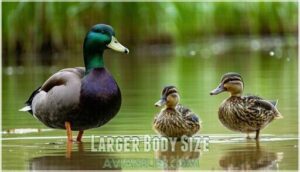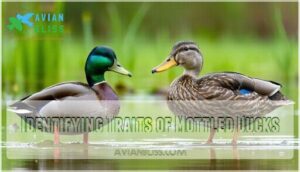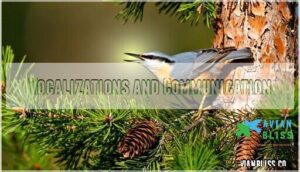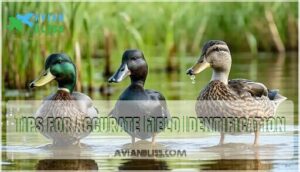This site is supported by our readers. We may earn a commission, at no cost to you, if you purchase through links.
 The comparison of mallard, black, and mottled ducks reveals distinct identification markers that’ll transform you from a confused observer into a confident duck identifier.
The comparison of mallard, black, and mottled ducks reveals distinct identification markers that’ll transform you from a confused observer into a confident duck identifier.
Mallards showcase sexual dimorphism with males sporting iridescent green heads and chestnut breasts, while females display mottled brown patterns.
Black ducks wear uniform chocolate-brown plumage with distinctive white eye crescents, and mottled ducks feature darker brown bodies with bright yellow bills marked by a dark base spot.
Their habitat preferences differ substantially too—mallards adapt to diverse wetlands including urban areas, black ducks prefer coastal marshes in eastern North America, and mottled ducks stick to southeastern U.S. coastal regions without migrating.
The subtle variations in bill coloration, body proportions, and behavioral patterns hold the keys to mastering waterfowl identification in the field.
Table Of Contents
- Key Takeaways
- Physical Characteristics of Mallard Ducks
- Distinguishing Features of Black Ducks
- Identifying Traits of Mottled Ducks
- Habitat Preferences and Distribution
- Behavioral Differences Among Duck Species
- Vocalizations and Communication
- Breeding and Nesting Habits
- Conservation Status and Threats
- Tips for Accurate Field Identification
- Frequently Asked Questions (FAQs)
- What is the difference between a mottled duck and a Mallard?
- How to tell a black duck from a mottled duck?
- How to tell the difference between a black duck and a Mallard?
- What does a mottled duck look like?
- How do these duck species interact with each other?
- What are their typical lifespans in the wild?
- How do they adapt to urban environments?
- What are their main predators besides humans?
- How do climate changes affect their migration patterns?
- How do hybrids affect species identification accuracy?
- Conclusion
Key Takeaways
- You’ll distinguish these three ducks by their bills: mallards have bright yellow-orange bills (males) or orange-brown bills (females), black ducks display olive-yellow bills with darker markings, and mottled ducks sport distinctive yellow bills with dark base spots.
- You can identify them by body coloration patterns: male mallards show iridescent green heads with chestnut breasts, black ducks wear uniform chocolate-brown plumage with white eye crescents, and mottled ducks feature darker brown bodies with notably paler heads.
- You’ll find them in different habitats: mallards adapt to diverse wetlands including urban areas, black ducks prefer coastal marshes in eastern North America, and mottled ducks stick to southeastern U.S. coastal regions without migrating.
- You should watch for behavioral differences: mallards are strong migrants using major flyways, black ducks show partial migration with some staying year-round, while mottled ducks remain sedentary and make only local habitat adjustments rather than true migration.
Physical Characteristics of Mallard Ducks
You’ll notice mallards display the most dramatic sexual dimorphism among these three duck species, with males sporting brilliant emerald-green heads and chestnut breasts while females show mottled brown plumage throughout.
Their broad, flattened bills range from yellow-green in males to orange-brown with dark spots in females, making bill color a reliable identification marker.
Plumage Colors
When you’re identifying mallards in the field, you’ll encounter striking plumage color variations that set them apart from their relatives.
Male mallards display vibrant iridescent green heads with iridescent hues and rich chestnut breasts, while females show complex feather patterns with mottled brown color variations.
These plumage differences create distinct visual signatures that help with plumage pattern recognition during duck species comparison, making mallard duck identification more straightforward than you’d expect.
Bill Shape and Color
Mallard bill color serves as your most reliable field mark for accurate identification.
Males display bright yellow-green duck bills, while females show orange-brown beak shape with darker bill patterns.
The broad, flattened bill color identification differs markedly from mottled beaks and provides essential duck characteristics alongside speculum characteristics for proper bill color analysis.
Size and Weight
Beyond bill coloration, body mass provides another reliable identification marker for mallard duck species comparison.
Adult males typically weigh 2.2-3.5 pounds, while females range from 1.6-3.1 pounds, showing clear size variation between sexes.
Understanding these morphology differences helps distinguish them from similar duck species:
- Length: 20-26 inches from bill tip to tail
- Wingspan: 32-39 inches across extended wings
- Weight comparison: Lighter than black duck, heavier than mottled duck
- Growth patterns: Males develop larger body mass during breeding season
Distinguishing Features of Black Ducks
Black ducks stand out as the darkest members of this waterfowl trio, sporting rich chocolate-brown plumage that’s markedly darker than both mallards and mottled ducks.
You’ll recognize them by their distinctive pale eye crescents and sturdy build, which makes them appear larger and more substantial than their counterparts, with a notable sturdy build.
Dark Plumage Coloration
American Black Ducks showcase distinctive dark chocolate brown feathers that create their signature appearance.
Their dark shades result from high feather pigmentation levels, creating consistent color patterns across their bodies.
Unlike other duck plumage differences, Black Ducks maintain uniform coloration without the speculum characteristics found in related waterfowl species, distinguishing them from mallard duck and mottled duck species with their melanin-rich plumage variations that appear almost black in certain lighting conditions.
White Eye Crescent
You’ll notice black ducks display a distinctive white eye crescent that contrasts sharply with their dark chocolate-brown head feathers.
This eye marking creates a prominent facial feature that helps distinguish them from mallard duck and mottled duck species.
The white crescent appears as a curved line behind the eye, making it a reliable field identification marker for waterfowl identification.
Larger Body Size
Body mass serves as a reliable field marker when conducting waterfowl comparison between these three duck species.
You’ll notice black ducks consistently outweigh both mallard duck and mottled duck specimens, with weight factors ranging from 2.2 to 3.5 pounds compared to mallards’ 1.6 to 3.5 pounds.
This size comparison becomes particularly evident during flight observations, where scaling effects make black ducks appear markedly more robust.
Growth rates also differ substantially among species, affecting overall body proportions and field identification accuracy.
Identifying Traits of Mottled Ducks
You’ll find mottled ducks easier to identify once you know their signature features: darker brown bodies with distinctly paler heads and bright yellow bills.
Their purple wing patches lack the white borders that frame mallard speculums, making this a reliable field mark for separating these similar species, with distinctly paler heads being a key distinguishing feature.
Plumage Patterns
Mottled duck plumage patterns create a distinctive mosaic that separates them from their waterfowl relatives.
Their feather colors blend brown and buff tones across the body, while wing patterns display subtle speculum characteristics without white borders.
You’ll notice these key plumage pattern recognition features:
- Mottled brown body with lighter head markings
- Buff-colored feather patterns on breast and flanks
- Dark wing coverts contrasting with lighter primaries
- Plumage texture appears coarser than mallard duck counterparts
Understanding the mottled duck habits is essential for identifying these unique characteristics of the mottled duck, which are crucial for identification and recognizing their distinctive features.
Bill Characteristics
When identifying mottled ducks, bill color serves as your most reliable field mark for distinguishing them from similar species.
The bill displays olive-green to yellow coloration with a distinctive dark spot at the base.
| Feature | Mottled Duck | Mallard Duck |
|---|
Bill Color
Dark Markings
Bill Size
Nostril Shape
Bill Texture
This bill color identification helps separate mottled ducks from mallards during duck species comparison and speculum characteristics analysis.
Body Shape and Size
The anatomy of these southeastern waterfowl reveals distinct Duck Proportions that set them apart from their mallard duck cousins.
Body Length typically measures 20-24 inches, while their stockier build creates different visual proportions than the sleeker black duck.
- Wing Span: Broader wings relative to body size
- Feather Density: Dense, water-resistant plumage layers
- Beak Size: Proportionally larger bills than mallards
- Weight: Heavier build at 1.5-2.5 pounds
Habitat Preferences and Distribution
Understanding where these three duck species live helps you know which birds you’re likely to encounter in different regions.
Each species has adapted to specific environments, with mallards showing the greatest habitat flexibility while mottled and black ducks prefer more specialized wetland systems, and this is a key factor in determining their distribution, with habitat flexibility being crucial for their survival.
Mallard Duck Habitats
Mallard Ducks thrive in diverse wetland ecosystems across North America, Europe, and Asia. You’ll spot these adaptable waterfowl in freshwater marshes, lakes, ponds, and even urban parks with retention basins.
| Habitat Type | Water Depth | Vegetation |
|---|---|---|
| Prairie Potholes | Shallow (1-3 ft) | Dense emergent |
| Urban Ponds | Variable | Managed/sparse |
| Coastal Marshes | Tidal zones | Mixed aquatic |
Mallard habitat preferences include aquatic environments with abundant food sources and nesting cover. Unlike other duck species, mallards readily adapt to human-modified landscapes, making them successful residents of city parks and suburban water features. Understanding their duck habitat needs is essential for conservation efforts.
Black Duck Preferred Environments
American Black Ducks thrive in eastern North America’s diverse aquatic environments, showing remarkable adaptability across multiple habitat types.
You’ll find these resilient waterfowl in coastal marshes, freshwater wetlands, forested swamps, brackish areas, and estuarine habitats throughout their range. Black duck species identification becomes easier when you understand their preferred duck habitat locations.
- Forested Swamps: Dense woodland areas with standing water provide ideal nesting cover
- Coastal Marshes: Salt-tolerant vegetation offers abundant invertebrate food sources
- Freshwater Wetlands: Shallow ponds and marshes support diverse aquatic plant communities
- Brackish Areas: Mixed salinity zones create rich feeding opportunities year-round
- Estuarine Habitats: River mouths provide critical staging areas during migration periods
These duck species identification experts favor secluded environments with minimal human disturbance. Waterfowl characteristics include strong site fidelity, returning to traditional breeding grounds annually.
Mottled Duck Range and Locations
Unlike American Black Ducks found in eastern regions, Mottled Duck geographic distribution centers on coastal regions of the southeastern United States.
You’ll spot these non-migratory waterfowl from Florida through Texas, with concentrated populations thriving in specific wetland ecosystems despite ongoing habitat loss challenges.
- Primary range: Florida’s year-round resident population plus Gulf Coast from Alabama to Texas
- Preferred locations: Brackish marshes, rice fields, and shallow freshwater areas within 50 miles of coastline
- Migration patterns: Unlike other duck species identification markers, mottled ducks remain sedentary, making duck habitat ranges predictable for waterfowl identification purposes
Behavioral Differences Among Duck Species
You’ll observe distinct behavioral patterns that help distinguish these three duck species in the field.
Each species exhibits unique feeding techniques, courtship displays, and migration habits that complement their physical identification features.
Feeding Habits
Feeding behaviors reveal distinct foraging methods among these species.
You’ll observe mallard ducks dabbling in shallow water, tipping forward to access aquatic plants and seeds comprising 60-80% of their diet.
Black ducks prefer bottom-feeding in secluded wetlands, consuming invertebrates and acorns.
Mottled ducks skim surfaces for crustaceans while probing muddy substrates, showing unique nutrient intake patterns across coastal marshes.
Mating Rituals
When observing courtship displays, you’ll witness fascinating breeding behaviors that distinguish these species.
Mallard duck males perform elaborate head-bobbing and whistle-calls during mate selection, while Black Duck Species rely on subtle vocalizations and synchronized swimming for pair bonding.
Mottled Duck Identification reveals intermediate mating habits combining visual and vocal cues.
These distinct Mallard breeding habits showcase each species’ unique approach to reproduction and partner attraction.
Migration Patterns
Understanding migration patterns reveals each duck species’ unique seasonal movements.
Mallards are strong migrants using major flyways for long-distance travel, while black ducks show partial migration with some populations remaining year-round residents.
Mottled ducks exhibit minimal seasonal movements, making local habitat adjustments rather than true migration.
- Flyways and stopovers: Mallards follow established migration routes with strategic stopover sites, unlike the sedentary mottled duck species.
The study of bird migration patterns is essential for understanding these differences in migratory behavior among duck species.
Vocalizations and Communication
You’ll quickly discover that each species produces distinct vocalizations that serve as reliable identification tools in the field.
Understanding these acoustic differences helps you confidently distinguish between mallards, black ducks, and mottled ducks even when visual identification proves challenging, using reliable identification tools.
Mallard Duck Calls
Mallard duck vocalizations reveal fascinating call patterns through their vocal range.
These duck sounds include the classic "quack-quack" for alerting, soft grunting feed calls, high-pitched whistles during mating, and rapid alarm quacking.
Males produce distinctive whistle-calls that create unique sound waves.
Understanding these quack types helps identify mallard duck behavior and distinguishes this duck species from others during bird species comparison fieldwork, which involves recognizing mallard duck vocalizations and their role in bird species comparison.
Black Duck Sounds
Black duck’s raspy quacks create a distinctive vocal range that’s noticeably different from mallard duck calls.
Their low, guttural call produces unique sound waves, while females deliver louder quack patterns.
These duck vocalizations help distinguish this bird species comparison from other waterfowl through specific call frequencies and characteristic duck noises.
Understanding the black bellied whistling duck’s vocalization patterns is essential for accurate identification and study of their behavior.
Mottled Duck Vocalizations
While Black Ducks produce harsh, raspy calls, Mottled Duck vocalizations offer their own unique vocal traits.
These coastal marsh specialists communicate through distinct quack patterns that help waterfowl enthusiasts distinguish them from Mallard Duck calls.
- Raspy, low-pitched quacks with guttural undertones
- Short grunts during feeding activities
- Soft whistles during flight maneuvers
Their sound waves carry less frequently than typical bird songs, reflecting their secretive nature. They also have a unique way of making sounds that are different from other ducks, with distinct quack patterns.
Breeding and Nesting Habits
Understanding breeding patterns helps you distinguish these three duck species during nesting season when plumage differences might be less obvious.
You’ll find that while all three species share similar reproductive timelines, their nesting preferences and egg characteristics offer reliable identification clues.
Mallard Reproduction
Breeding-season dynamics showcase Mallard duck reproductive success through systematic patterns.
During spring courtship, breeding male Mallards establish territories while females select prime duck nesting sites near water sources.
The Mallard species exhibits remarkable breeding habits, with females laying 8-13 cream-colored eggs in concealed ground nests.
Egg incubation lasts 26-28 days, exclusively managed by hens, guaranteeing rapid duckling development.
This reproductive cycle ensures young achieve flight capability within two months of hatching, showcasing the species’ reproductive success.
Black Duck Nesting Behavior
When you observe black duck nesting sites, you’ll notice females select ground locations in wooded areas, marshes, or islands for maximum concealment.
These secretive birds construct shallow depressions lined with grass and down feathers.
Egg laying produces 6-14 cream-colored eggs with incubation periods lasting 23-33 days, while females handle brood care independently using carefully chosen nest materials.
The female’s role in duck breeding habits is essential for the survival of the species.
Mottled Duck Breeding Seasons
You’ll find mottled duck breeding patterns begin remarkably early in the year.
Unlike migratory mallard duck and black duck species, these non-migratory ducks start courtship rituals in January.
Their nesting sites include dense vegetation near coastal marshes, where females select ideal locations for egg laying.
The incubation period lasts approximately 25 days, with hatchling care extending through summer months.
Their nests are often built near dense growth.
Here are three remarkable aspects of their duck breeding cycle:
- Early courtship displays occur when other duck species are still wintering elsewhere
- Secretive nesting behavior helps protect eggs from numerous coastal predators
- Extended parental care guarantees ducklings develop survival skills in challenging wetland environments
Conservation Status and Threats
Understanding the conservation status of these three waterfowl species helps you appreciate their ecological importance and current challenges.
Each species faces unique threats that affect their population stability and long-term survival prospects.
Mallard Population Trends
Looking at breeding success, mallard populations face mounting challenges across North America.
Recent surveys show concerning drops, with numbers declining 23% since 2015. Habitat Loss from agricultural expansion and Climate Impacts disrupting migration patterns contribute substantially to these trends.
- Hybridization Risks with domestic ducks threaten genetic integrity of wild populations
- Urban Adaptation provides stability while rural populations struggle with Hunting Pressure and wetland drainage
Wildlife Conservation efforts through wetland restoration programs offer hope for stabilizing Duck Species numbers.
Black Duck Conservation Efforts
Why do American Black Ducks struggle while their Mallard cousins thrive?
Black Duck conservation efforts target critical threats through habitat restoration, hunting regulations, and pollution mitigation.
Wildlife conservation groups focus on habitat preservation in northeastern wetlands, where genetic diversity remains vulnerable.
Climate resilience programs address shifting migration patterns, while duck conservation initiatives combat illegal hunting.
These conservation efforts aim to stabilize declining populations through holistic strategies.
Mottled Duck Habitat Concerns
Mottled Duck populations face mounting habitat concerns across their southeastern range. Habitat Loss from urbanization threatens 72% expansion by 2100, while Sea Level rise eliminates over 70% of Louisiana’s coastal marshes.
Extreme Weather events disrupt breeding cycles, and Disease Susceptibility increases in degraded Wetland Areas. Hybridization Risks compound these challenges as Duck Habitat fragments:
- Coastal marsh degradation from saltwater intrusion
- Urban development isolating Mottled Duck populations
- Agricultural conversion destroying nesting sites
- Invasive vegetation reducing Habitat Preferences
Conservation Efforts now prioritize habitat restoration in predicted loss zones. Protecting wetlands is essential for long-term survival of mottled ducks.
Tips for Accurate Field Identification
When you’re in the field, you’ll need to focus on specific diagnostic features to distinguish these three similar duck species.
Bill color, speculum borders, and overall body contrast serve as the most reliable identification markers, though hybridization can create confusing intermediate characteristics.
Key Features to Observe
Master duck identification by examining plumage details carefully.
Check bill coloration differences between species—mallards show yellow bills while black ducks display olive-green coloring.
Study speculum edges closely, as mallard duck wing patches feature distinctive white borders.
Note body size variations and watch for hybrid indicators that complicate identification.
To improve accuracy, consult a mallard identification resource.
Focus on duck plumage differences systematically to distinguish these duck species accurately in field conditions.
Common Misidentifications
Field identification challenges plague even experienced waterfowl observers, with error rates reaching 40% in hybrid zones.
Even seasoned waterfowl experts struggle with duck identification, especially when hybrids blur the lines between species
Female Mallard Ducks, Black Ducks, and Mottled Ducks share remarkably similar brown plumage, creating persistent Duck Identification problems.
Novice Mistakes multiply when Lighting Influence affects Duck Plumage Differences, making bill color appear misleading.
Many resources discuss Mallard vs Black duck comparisons.
Key confusion points include:
- Hybrid Identification – Mixed ancestry creates intermediate features that don’t match field guides
- Plumage Variation – Seasonal changes and individual differences blur species boundaries
- Bill Imperfections – Wear, injury, or fading can mask diagnostic markings
Frequently Asked Questions (FAQs)
What is the difference between a mottled duck and a Mallard?
You’ll spot key differences in bill color and body darkness between these waterfowl species.
Mottled ducks display yellow-orange bills and lighter brown plumage, while mallard females show orange bills with darker mottling patterns.
How to tell a black duck from a mottled duck?
Black ducks appear much darker with chocolate-brown feathers and purple wing patches, while mottled ducks show lighter brown plumage with pale heads and yellow bills.
How to tell the difference between a black duck and a Mallard?
Experienced birders know that 85% of waterfowl misidentifications involve these similar species.
You’ll distinguish black ducks from mallards by examining bill color: mallards sport bright yellow-orange bills while black ducks display olive-yellow ones with darker markings.
What does a mottled duck look like?
You’ll recognize a mottled duck by its dark brown body with lighter, paler head coloring.
The yellow bill stands out, along with a distinctive purple wing stripe and white underbelly that creates nice contrast.
How do these duck species interact with each other?
You’ll observe these three duck species interacting primarily through hybridization, especially between mallards and mottled ducks in overlapping territories like Florida and Texas, creating genetic concerns for conservation efforts.
What are their typical lifespans in the wild?
Wild duck lifespans typically range from 5-10 years, though you’ll find mallards often reach 7-10 years while mottled and black ducks average 5-7 years in natural conditions.
How do they adapt to urban environments?
Mallards thrive in urban settings, adapting easily to parks and city ponds where you’ll find them begging for bread.
Black and mottled ducks rarely venture into cities, preferring their natural marsh habitats over concrete landscapes.
What are their main predators besides humans?
Like a predatory web encircling wetland nurseries, natural threats stalk these ducks daily.
You’ll find raccoons, snakes, and foxes raiding nests while raptors like hawks target adults.
Snapping turtles, mink, and weasels hunt ducklings in water.
How do climate changes affect their migration patterns?
Climate changes affect these ducks’ migration patterns by shifting timing and routes.
You’ll see mallards migrating later in fall, staying north longer due to warmer temperatures, while altered precipitation changes their traditional stopover sites.
How do hybrids affect species identification accuracy?
You’ll struggle to identify species correctly when hybrids muddy the waters.
Their intermediate features—like bill colors between yellow and orange—throw off traditional field marks, making positive identification nearly impossible without genetic testing.
Conclusion
Mastering the comparison of mallard black and mottled ducks requires observing key field marks, understanding habitat preferences, and recognizing behavioral patterns.
You’ll identify mallards by their sexual dimorphism and adaptability, black ducks by their uniform dark plumage and white eye crescents, and mottled ducks by their southeastern coastal distribution and distinctive yellow bills.
These identification skills will enhance your waterfowl observation experiences substantially.
- https://www.audubon.org/field-guide/bird/mottled-duck
- https://macaulaylibrary.org/photo/63736171
- https://www.massaudubon.org/our-work/birds-wildlife/bird-conservation-research/breeding-bird-atlases/find-a-bird-bba1?id=47
- https://www.ducks.org/conservation/where-ducks-unlimited-works/northeastern-us-forests
- https://pmc.ncbi.nlm.nih.gov/articles/PMC9942969/
















